By Audrey Fuller, Brandon Korn & Gabe Frahm
Imagine RIT
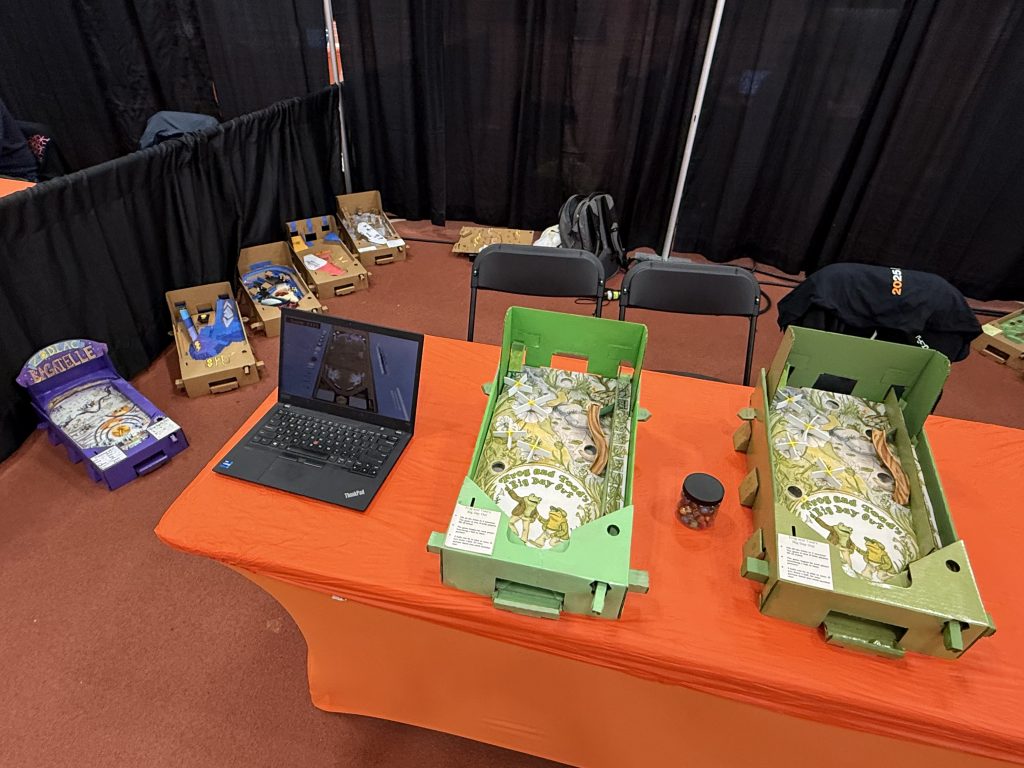
Audrey: The one-hour shift was extremely fun, but ended up being way more exhausting than I expected lol. Either way, seeing kids try out the games and saying hi to friends stopping by made it a great experience!
Gabe: The one hour shift was fun, but also extremely hectic. I was surprised how many kids instinctually repeatedly smashed the flipper buttons as hard as they could, which led to a couple on the fly repairs. There were a couple times where people who kind of knew what they were doing would play our games, and it was very fun to watch them experience them! I did definitely learn that the spinners on Frog and Toad would wear quickly, and start to stick! The next day in class, we reinforced the spinner pins underneath with more cardboard and hot glue!
Brandon: Imagine RIT was a fun experience, although I mostly just helped with setup. I had the first shift, so I helped set up the booth, but I had to leave somewhat early for my other Imagine shift for my card game I’ve been developing, so my Imagine experience was pretty short
The main repairs we all completed after the demo involved a lot of gluing components such as the spinners on frog & toad and wires on the bagatelle back down. Additionally, the most common point of failure during Imagine itself was the rubber bands in the flippers snapping, so we had to do a significant amount of quick repairs during the shift itself. We also re-taped the cups on the underside of the pinbox back down.
While we didn’t make any changes to the physical machines, the digital one went through a few modifications. We realized that the top-right corner was a bit bare and uninteresting compared to the other sections of the playfield, so we mapped the multiball target there. We also added a ramp going up the side wall to hit the wizard on top of the tower, which opens after completing the challenges. We also added some additional texturing to the ramps and walls to make it look nicer. We also realized one of the last second changes hindered the ball movement in “BumperWorld” so we had to change that on the fly!
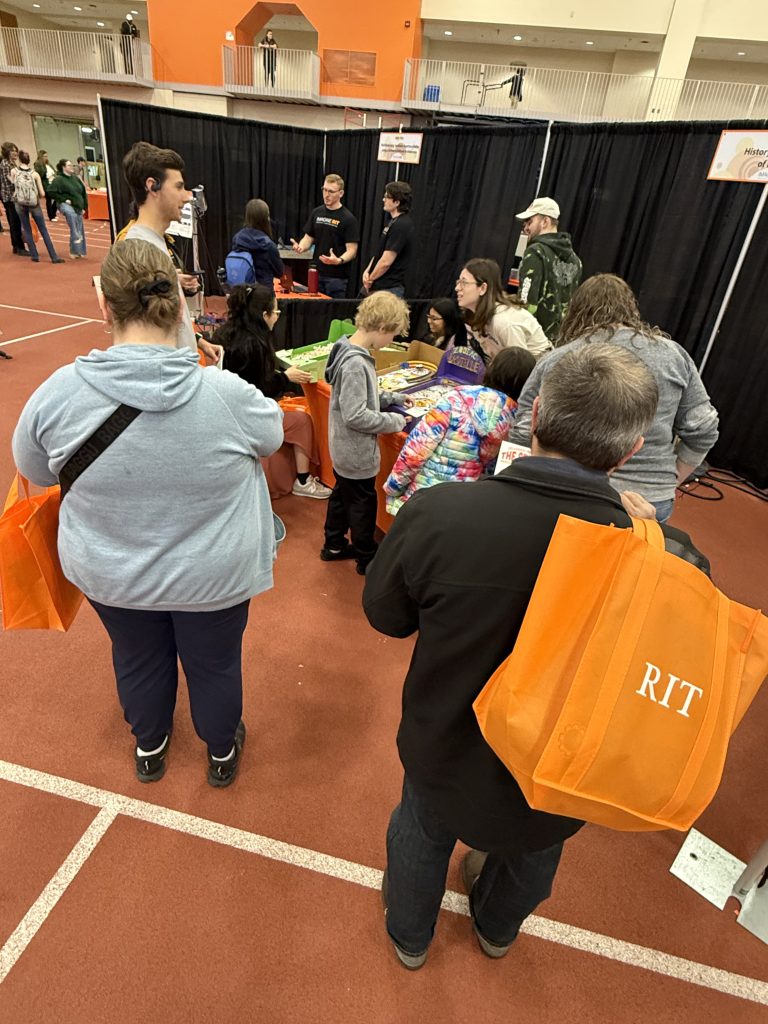
Strong Museum Pinball Day
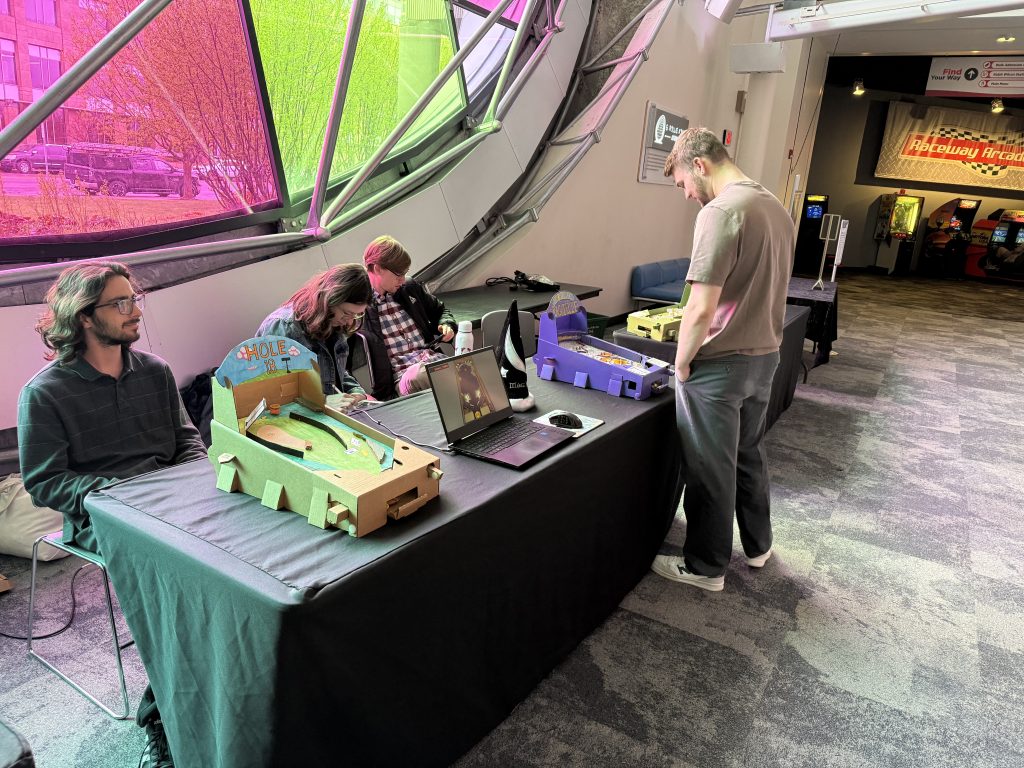
Audrey: The strong museum shift felt a lot easier, despite it being longer. I think this was largely due to the fact that it wasn’t as busy at first, and only started to pick-up around noon. Thankfully fewer people playing the machines meant that there wasn’t any repairs that needed to be done at the time, though marbles were often being lost or stolen by the children.
Gabe: The people that came to our exhibit at the Strong museum were very fun to engage with. There were at least two groups of kids who couldn’t get enough of Frog and Toad and the parents of both groups told us we should market the game! There were a couple of times kids would hit the flippers hard (again) and I needed to swap out two rubber bands during the shift. We had a lot more time to work with individual people at the Strong, and was overall a more relaxed experience than Imagine RIT.
Brandon: The Strong expo was pretty long. I made the mistake of not eating breakfast that morning, and I was feeling it pretty hard by the end. But the kids that walked up were all super fun to talk with. Each person loved the frog and toad theme and the beautiful art. I think also our game being the only one colored brought in a lot of customers. It was a super fun experience overall
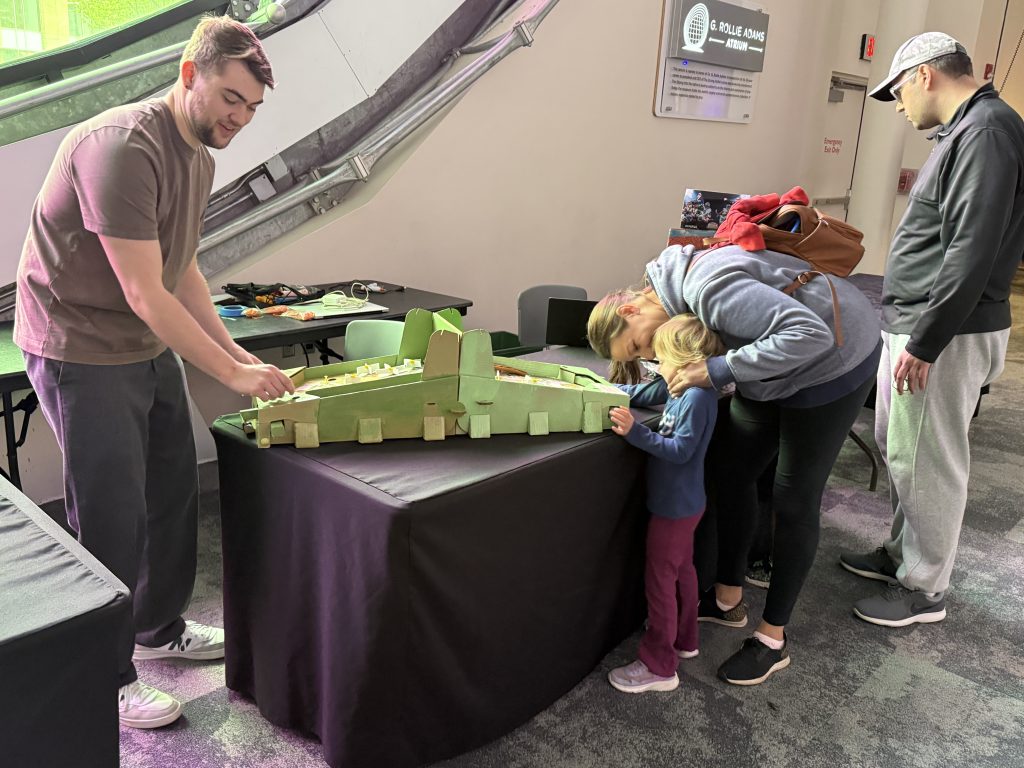
Audrey: I feel like I learned a lot more about explaining how to play the games in the simplest way possible to kids. Since they were on average younger than the people at Imagine, I had to simplify and shorten some of the rules. This made the bagatelle machine a lot more approachable for kids, as they were often confused about how to use the flippers on the frog & toad machine and got board quickly.
Gabe: It was very surprising for me to see, both here and at Imagine, how unintuitive Pinball is to most people. When we toured the Strong earlier, I laughed at some earlier pinball machines that felt like they had to point out where the flippers and buttons were, but after having some kids play our games who’ve probably never seen Pinball before it makes total sense. There were multiple kids that I had to show where the buttons were (or that there were even buttons at all!!) It was very fun to watch kids get into the groove of the game, and get competitive with one another!
Brandon: I got a lot of joy just watching new people, and kids, interacting with our pinball. I was feeling pretty worn out from classes for the semester, and working on the pinball machines. But watching people just enjoy our pinball machines brought a lot of energy back to me.
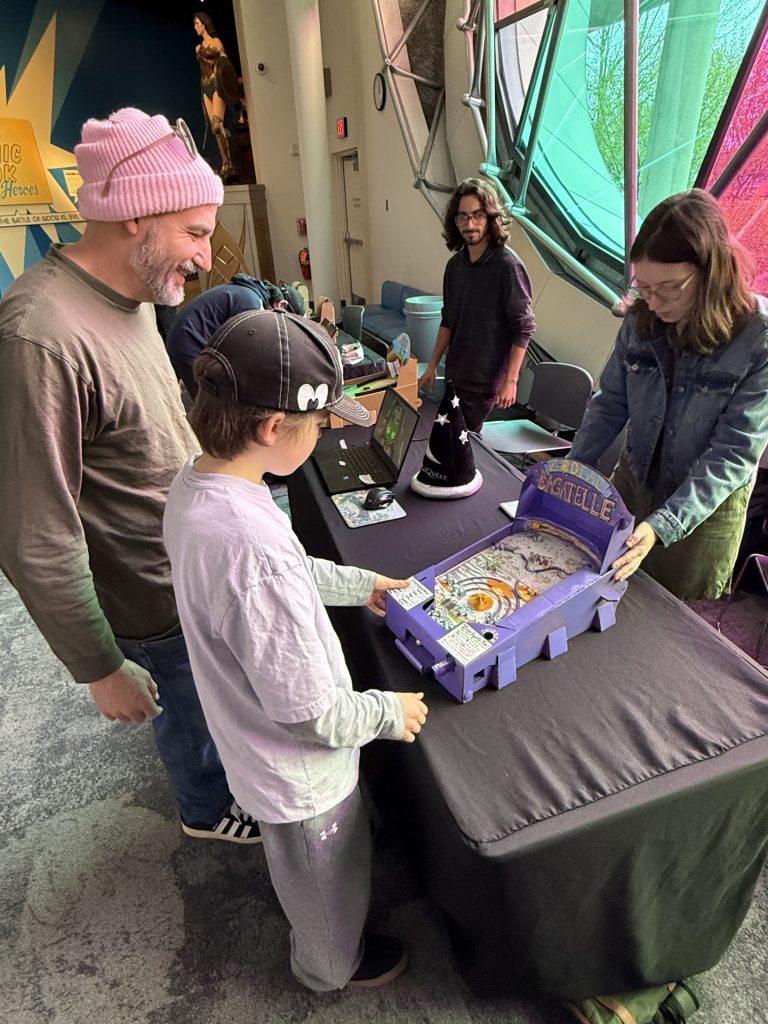
Audrey: I was really impressed by the machines Ben and the other leaders brought. They all did really well at showing the full extent of the pinbox’s capabilities, and all the interesting features you can include even without electronics. For example, I really liked the neon spaceship machine, which used lots of sloped pathways to let the ball build up speed and make the game feel extra snappy. The way they used elastic gates was also really interesting, in how hitting them once triggers them to open. My favorite out of all the machines they brought in though was Swamp Quest. While the gameplay itself was fairly simple and straightforward, GhostShrimp’s art really elevated it to the next level. It was also cool hearing their iterative design philosophy being best received in educational settings.
Gabe: I was amazed by some of the games Ben brought that they had made with the Pinbox 3000 kit. The mechanisms for drop targets and additional mini flippers higher up on the playfield were especially fascinating! It’s very easy to think “there’s only so much we can do with cardboard machines,” but seeing what the Pinbox team was able to accomplish with some creativity was really humbling!!
Brandon: I was flabbergasted by the machines Ben brought. There was so much detail and innovation that I would never have thought of. I mostly remember the pinball machine with palmtrees and the wooden door. I also really liked the tic-tac-toe machine, where you are trying to get 3 in a row in the tic-tac-toe board, which is ingenious. It’s hard to do scoring/objectives in cardboard and that one was super simple and fun.
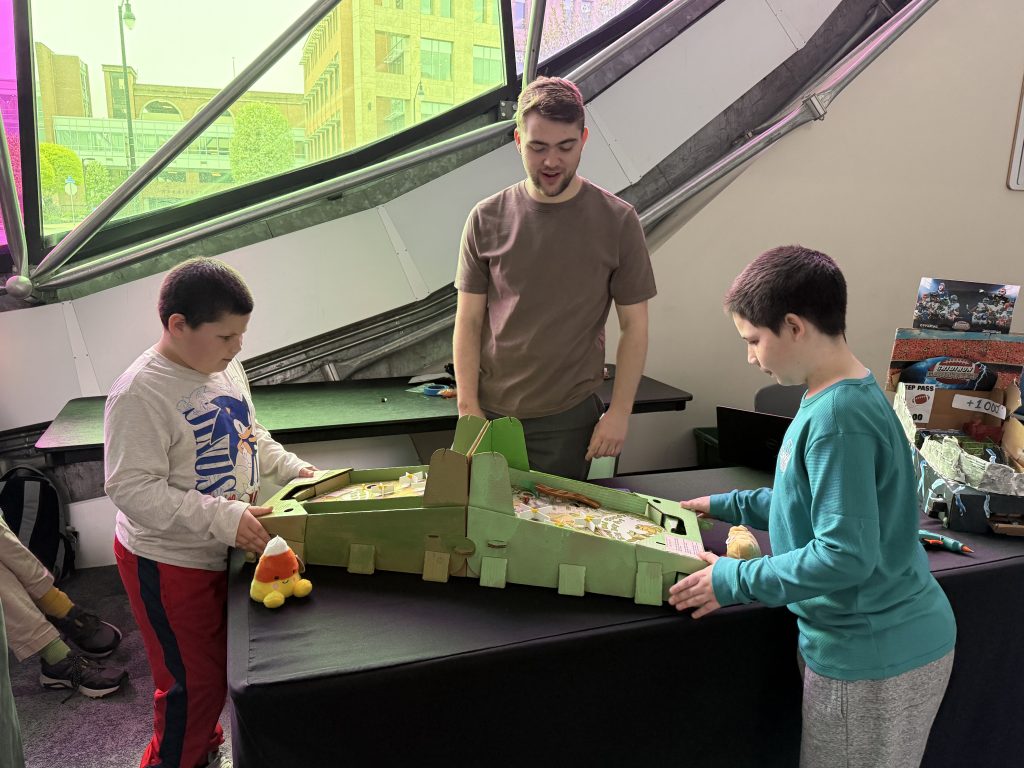
Takeaways From The Class
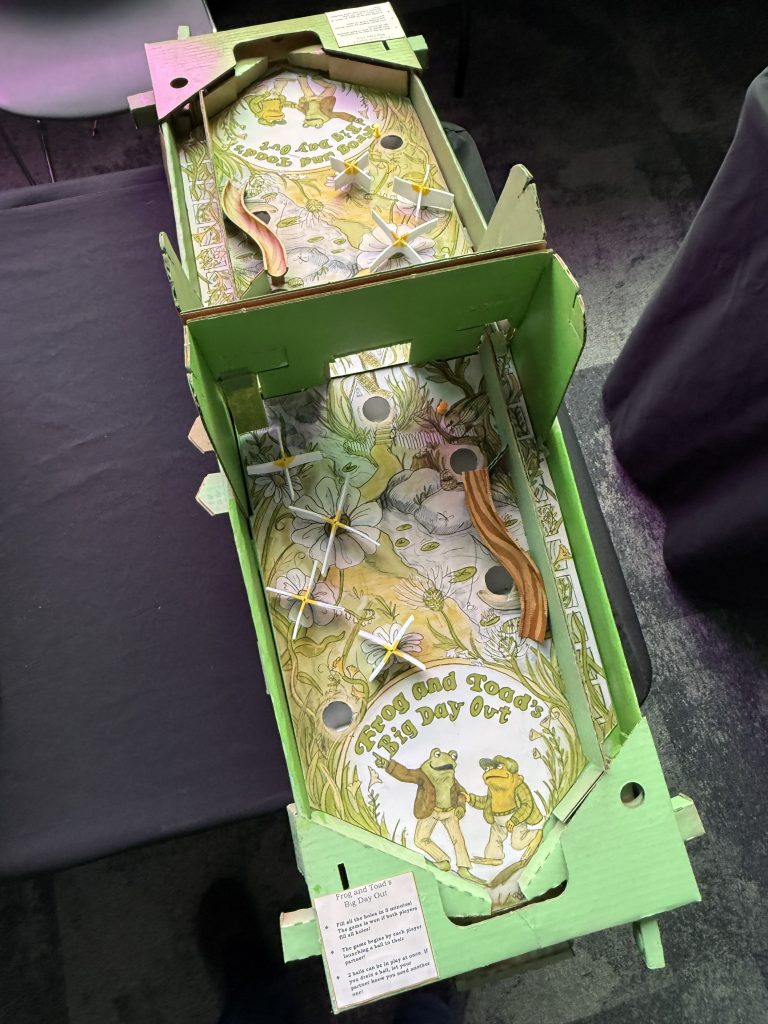
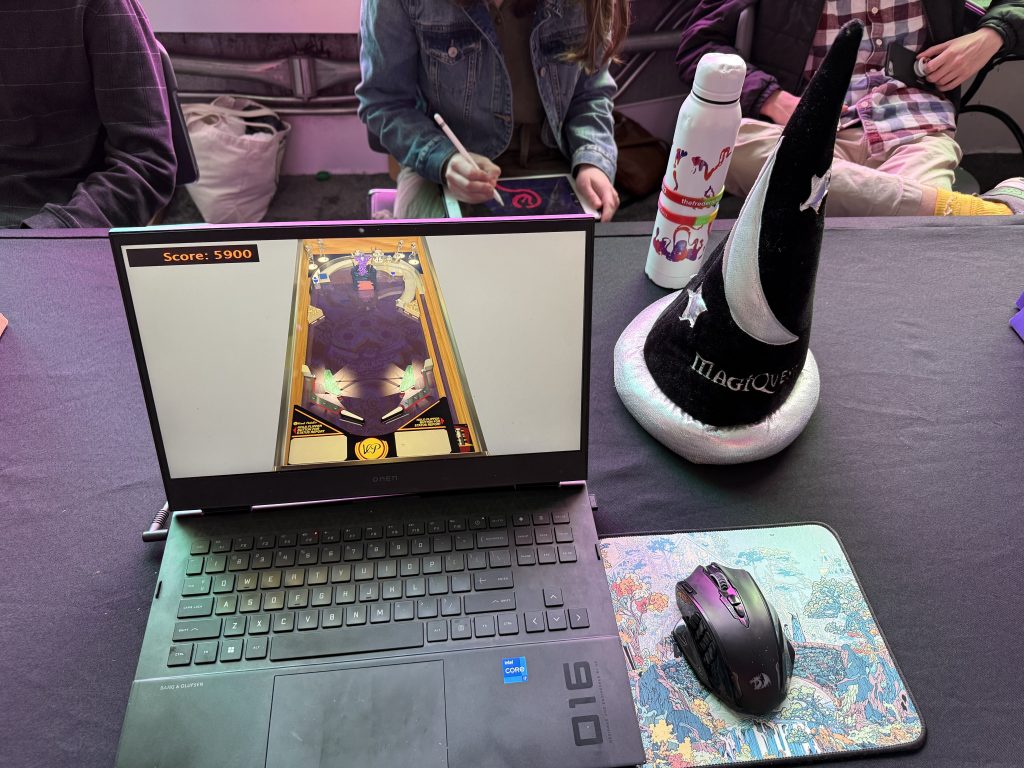
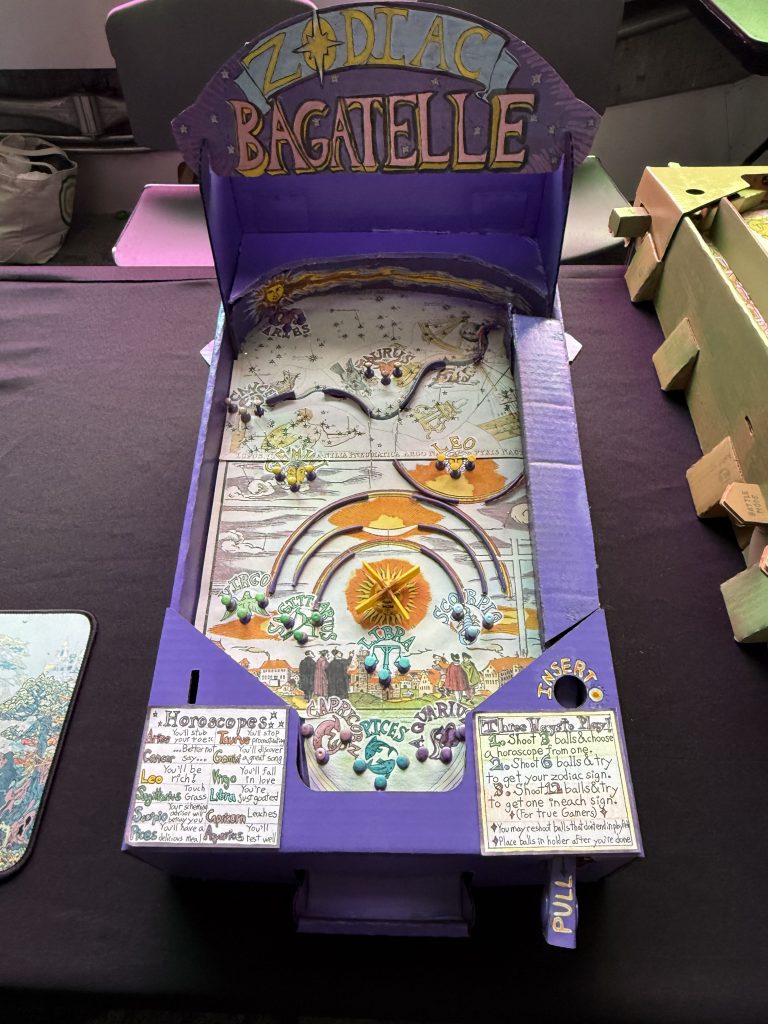
Audrey: Overall I had a bunch of fun with this class! Going into it I knew next to nothing about pinball history, but have really gained a greater appreciation for the advancements in both technology and game design that have influenced the modern pinball scene. It was also incredibly cool discovering how much of a pinball hub Rochester, NY is. Brandon ended up hosting ‘Pinball Friday’ where we would go out and play pinball at Arcade 80’s. One of the highlights of the class was definitely the guest speakers, I really enjoyed hearing about the pinball restoration process from Ashley Ludwig, and George Gomez really reframed how I thought of playfield design. My only wish for this course is that I had more time to create playfield art or try to make a computer vision-based scoring system, but there’s always a chance for that in the future!
Gabe: I wasn’t very sure what to expect going into this class, but it far exceeded what I thought it would be! I had very little experience with pinball prior, only playing a couple of times and struggling to keep balls alive without much more thought, but after learning more about it and being exposed to it more I’ve grown a deep appreciation for it! A couple machines I played through my discovery really stood out to me like Medieval Madness, Lord of the Rings, and most of all, Funhouse. All of these games are super different and showed off variety that I didn’t know was possible in pinball! There’s just something about the physicality of pinball, and the feeling of manipulating a real ball with real physics, that is hard to replicate in any other way. I loved all the amazing opportunities we had in this class at the Strong (both presenting and getting a behind the scenes look!), Imagine, and the presentations from multiple relevant people in the modern pinball scene. Talking with George Gomez especially was fascinating, and was really awesome! As fun as it was, my one wish for the course, would be to cut the time working on the bagatelle machines a little bit to make more room for visual pinball time! This was a fantastic experience and I wish Professor Jacobs a happy retirement!
Brandon: My biggest takeway from the class was the discussions and thought on the readability of games. I hadn’t played much pinball before, and I had previous thought that pinball was incomprehensible, even though I hadn’t really seen much pinball machines. But pinball machines has a lot of effort in telling the player how to play the game. There’s not much room for actual rules, and players won’t read text anyway, so a pinball playfield has to be understood while playing. I really like that type of design in general, and I got the opportunity to think about it a lot in regards to designing our pinball machines.
